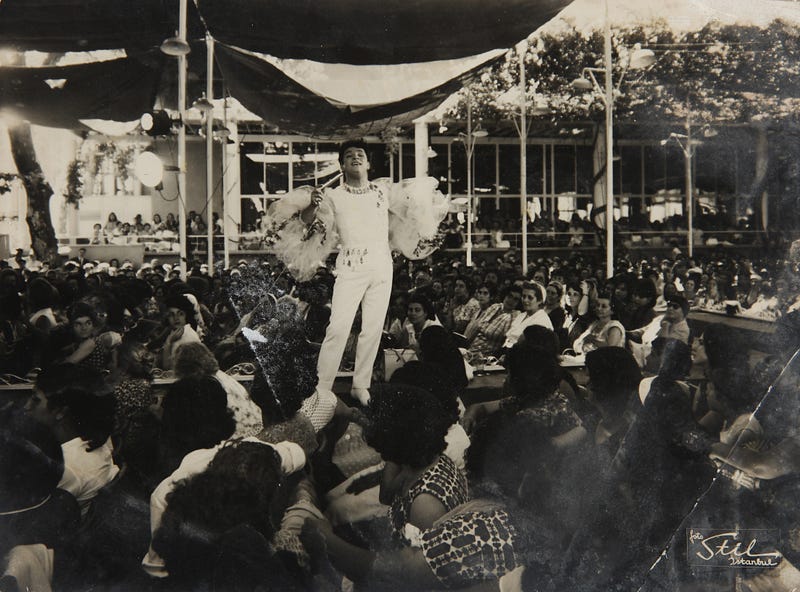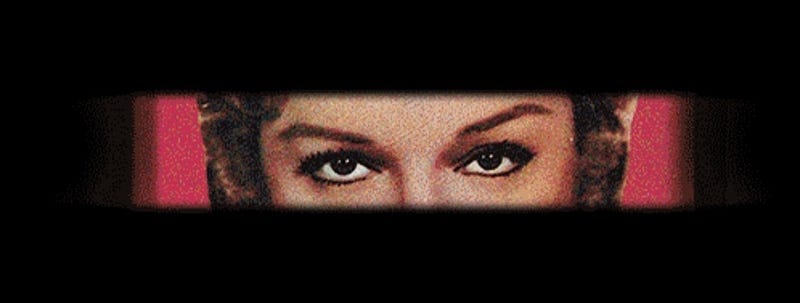Mixing old and new, a participatory documentary on a magnetic Turkish icon spotlights the potency of simple tools.
Outside the Turkish community, few might know of the cultural sensation Zeki Müren. This beating heart of classical “Turkish art music” was also the first and greatest national pop icon. He was adored for his unique voice and unparalleled eloquence. However, he was equally controversial. His idiosyncratic costumes, sophisticated makeup, and picture-perfect pompadours made headlines long before Prince or Bowie. Still, the gender-bending multitalented star was a cross-generational icon in a traditional yet transforming society. An unlikely hero, Müren connected with people almost universally, from conservative housewives and grandparents to the military, while also being hailed as a queer icon.
 An open air
performance of Zeki Müren (Image courtesy of Beyza Boyacioğlu)
An open air
performance of Zeki Müren (Image courtesy of Beyza Boyacioğlu)Documenting this sublime revolution is Zeki Müren Hotline (2021), a co-created interactive web experience that collects and curates people’s messages for the icon. Directed by documentary filmmaker Beyza Boyacioğlu and media artist Jeff Soyk, the project artfully engages an old-school hotline, a throwback to the ubiquitous ’90s phenomenon. Designed to be a phone-based experience, the project was declared a NetArt Honoree at the 2022 Webby Awards, the internet’s highest honor.
While Zeki never openly admitted or denied being gay, he was pushing the boundaries of gender norms within the constraints of his time. But today, the LGBTQ community is virtually non-existent in mainstream Turkish media due to alarming censorship. This makes such a participatory project even more consequential.
 Zeki Müren
Hotline (2021)
Zeki Müren
Hotline (2021)When you enter the project on your phone, Müren’s powerful voice and piercing gaze reverberate. As the mosaic stage unfurls, you see the artist’s life through his fans’ eyes. Each picture is a prism opening up different facets to the icon while also offering insight into Turkey’s socio-cultural and political history. Combined with insightful anecdotes and visuals, this is an intimate archive of lived experiences with real voices, where secrets and stories, confessions and queries all sit together.
Zeki Müren Hotline originated as a participatory experiment for Boyacioğlu’s Master’s thesis in 2015, almost two decades after Müren’s death. The hotline’s set-up was simple: strategically placed postcards at local spots across Istanbul invited everyday Turkish people to leave a message to/about Zeki Müren.
A testament to Müren and his magic, within a few months the hotline became an unexpected sensation, receiving hundreds of anonymous voicemails. A year later, when Boyacioğlu and Soyk met at the MIT Open Documentary Lab (ODL), the project evolved even further, morphing into the interactive documentary and mobile experience we see today.
As ODL alumni, Boyacioğlu and Soyk are no strangers to the rapidly evolving immersive tools and techniques pushing non-traditional forms of documentary. Yet Zeki Müren Hotline stands out for its powerful simplicity. In its retro and interactive format, the hotline calls upon individual and collective memories and nostalgia for the icon. Behind the scenes, I interviewed the directors to know more about their vision.
(Re)Collection: Assembling The Hotline A regular phone and a simple question, “Will Zeki Müren hear us?” formed the basis of the participatory experiment. Callers were even greeted with a “Hello, Zeki Müren speaking” from one of his movies, adding his ubiquitous personal touch.
When I asked why a telephone hotline, Boyacioğlu said, “Many people felt really comfortable telling intimate stories just because of this format.” She explained, “Since there was no microphone in front of them or a camera, they were just in the comfort of their homes, picking up the phone and telling a very intimate story, not knowing where it’s going to go.”
The messages reminded Soyk of earlier “story booths,” noting that the lo-fi audio quality of the messages captured on the tool also feels very analog, further lending a warmth to the stories.
To set up the hotline, Boyacioğlu used Vojo, an open-source tool that captures and communicates mobile phone stories, developed by the MIT Center for Civic Media and previously used in other iconic audio-based projects such as Quipu (2015).
Boyacioğlu recalled the unexpected surge of messages at the start. “The whole system broke, we didn’t realize what’s happening. It was because we didn’t have enough credits as so many people were calling.” She added that some of the messages were not even directly related to Müren, perhaps calls made for “comfort” or “to mark that day and time in some format.”
Finding Form In The Flood The directors shared that it was challenging to find the balance between paying tribute to Müren creating an extensive repository of calls and crowdsourced stories. But the audience participation played a guiding force in the project, creating a work that drew its power from collective storytelling and narratives rather than a singular vision. “The idea always was, what does he mean to people from all walks of life in Turkey? How can he be the common denominator for almost everyone? Being this queer icon, who’s supposed to be marginalized, he’s someone everyone just adores,” shared Boyacioğlu, citing this curiosity as inciting question.
Soyk added it was interesting what “unexpected results” could emerge from reaching out and listening to others. What’s important is “who’s telling the story, [and] when can you put it more on the general public to be storytellers and have them take the lead?” The curation of messages still delineates the artists touch, but without overpower the novelty and iteration in the collaboration.
Zeroing in on the format wasn’t straightforward. Delving into its making, Soyk explored many different possibilities for the project design. But the strength of the content led the way. “The messages themselves are so strong. We wanted to be mindful of not overshadowing those, the content with technology, or just trying to over-engineer the piece. Also, because it can just very easily detract from all that meaningful phone calls that are really at the heart of it,” said Soyk. “Even though a lot of the aesthetics and animation are pretty simple, we tried to make them thoughtful to complement messages as best as we could, given the limitations we were working with.”
(Re)Presentation Intimacy throughout the format plays a significant role. When you scroll through the mosaic, Müren’s piercing gaze feels like a visual anchor that holds attention. In the initial brainstorming, “fragmented storytelling” and “intimacy” emerged as the two main themes the makers wanted to explore. The focus was on creating an intimate, individualized interaction with the audience member from this deluge of crowd-sourced material. This translated into the user experience design for the phone and initial desktop version for exhibitions. Boyacioğlu shared, “Zeki played a lot with that personal interaction, trying to make the audience feel like they’re special. We wanted to create that, where you feel like Zeki is speaking to you or the people who called the hotline are speaking to you.”
Selecting the messages took on the form of several thematic sieves through which they filtered the possibilities. “We wanted to create a balance in terms of themes and the styles of the messages. Some messages are more story-based. Some are just feelings. Some are analyses about him that people had,” said Boyacioğlu. Given the interactive form, it was essential to carefully design the order of the messages and the emotional experience, whether to attempt a linear path or to allow a non-linear stroll through the database.
Blocks and Bridges Soyk, whose work leans towards nostalgia, memory, and media, was particularly fascinated by Zeki’s contradiction. He recalls how Boyacioğlu described Müren as the symbol for the LGBTQ community and the Republic’s young poster boy.
For Boyacioğlu, the project has the potential to attract people unaffiliated with the LGBTQ communities to “go see this because it’s Müren, but in the mix, also be exposed to these messages related to injustice towards LGBTQ people and their rights.” She hopes this project “can somehow create a bridge between these communities that usually don’t really touch each other.”
A documentary about Müren is not a first. Still, Zeki Müren Hotline goes beyond, becoming a lens to Turkey’s bygone days. Listening to the messages, it’s clear that Müren meant many things to many people. Not just as their treasured “Sun of Art,” but as a brother, friend, and confidant. Effectively weaving in the crowdsourced stories, the piece creates and preserves an intimate, individual, and collective experience. It harbors a unique potential to foster a shared space in a digital context — a space of reflection and connection — hopefully as piercing as Müren’s gaze.
For more news, discourse, and resources on immersive and emerging forms of nonfiction media, sign up for our monthly newsletter.
Immerse is an initiative of the MIT Open DocLab and Dot Connector Studio, and receives funding from Just Films | Ford Foundation, the MacArthur Foundation, and the National Endowment for the Arts. The Gotham Film & Media Institute is our fiscal sponsor. Learn more here. We are committed to exploring and showcasing emerging nonfiction projects that push the boundaries of media and tackle issues of social justice — and rely on friends like you to sustain ourselves and grow. Join us by making a gift today.